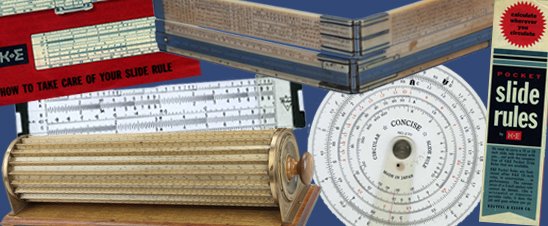This ten-inch aluminum linear slide rule is coated with white plastic (the "traditional" color). It has a nylon indicator and is held together with stamped aluminum squared posts. The front of the base has K, A, D, and DI scales, with B, ST, T, S, and C scales on the slide.
- Description
-
This ten-inch aluminum linear slide rule is coated with white plastic (the "traditional" color). It has a nylon indicator and is held together with stamped aluminum squared posts. The front of the base has K, A, D, and DI scales, with B, ST, T, S, and C scales on the slide. The left end of the slide is marked: MODEL (/) N1010-T (/) TRIG. The right end of the slide bears the style of Pickett logo used between 1958 and 1962. The number 74 appears above the logo.
-
The back of the base has DF, D, DI, and L scales, with CF, CIF, CI, and C scales on the slide. The left end of the slide is marked: COPYRIGHT 1959 © (/) PATENT APPLIED FOR. The right end of the slide is marked: PICKETT & ECKEL, INC. (/) 272.
-
The slide rule fits into a clear plastic bag and then into an orange-brown leather case lined in clear plastic. The triangular Pickett logo is embossed below the slot for the case's flap, and there is a metal ring on the back of the case for attaching to a belt. The slide rule arrived in a white, black, red, and yellow cardboard box. The 1958-1962 Pickett logo is superimposed on a model of the atom on the box. The top and bottom of the box are marked with several of the instrument's selling points: lifetime accuracy, all metal permanence; select a handy pocket size rule too (/) matched for your convenience by Pickett; micro divided scales; world's most accurate; safety liner case; completely guaranteed; complete instruction manual; slider tension springs.
-
Inside the box are four pieces of paper: a welcome note from company president John W. Pickett, marked Form 247; care instructions for the rule, marked Form 543; a guarantee, which indicates this instrument has serial number 252372; and a promotional flyer on Pickett's "eye-saver" yellow color, marked Form 225-A. See 1993.0559.01.01 for an instruction manual received in the box. One end of the box is marked: Pickett SLIDE RULE (/) all metal • guaranteed (/) A PRODUCT OF AMERICAN ENGINEERING AND MANUFACTURING. The other end of the box has a product label, which notes the Model N-1010-T Trig Slide Rule has the: Approved Scale Arrangement for basic work in all fields (Schools, Business, Industry) where Log Log scales are not needed.
-
The logo, nylon indicator with flat lens, straight style of posts, and company addresses in Chicago and Alhambra, Calif., are all consistent with a date around 1960. However, according to the donor, the slide rule was given to him by his parents as a Christmas gift in 1944.
-
References: Alan Boardman, "Recollections of a Pickett Industries Employee," Journal of the Oughtred Society 16, no. 2 (2007): 8; Walter Shawlee, "Pickett Slide Rules," http://www.sphere.bc.ca/test/pickett.html; Dieter von Jezierski, Slide Rules: A Journey Through Three Centuries, trans. Rodger Shepherd (Mendham, N.J.: Astragal Press, 2000), 75–76.
- Location
-
Currently not on view
- date made
-
ca 1960
- maker
-
Pickett & Eckel, Incorporated
- ID Number
-
1993.0559.01
- accession number
-
1993.0559
- catalog number
-
1993.0559.01
